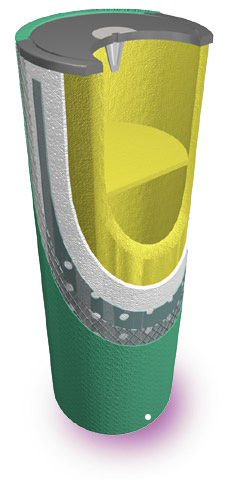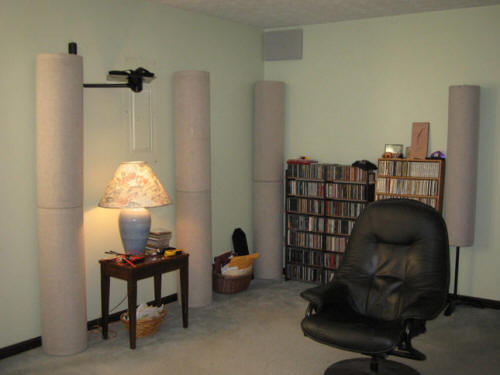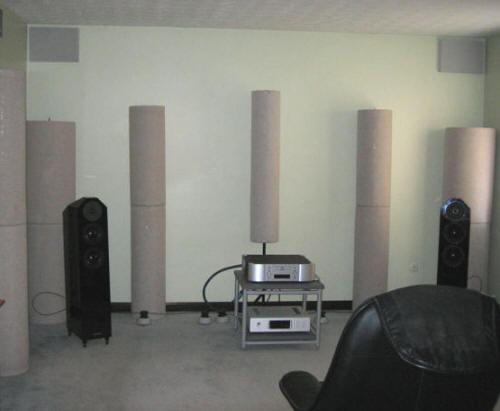
You are reading the older HTML site
Positive Feedback ISSUE
march/april 2007
asc
Tube Traps
as reviewed by John Acton

|
JOHN ACTON'S SYSTEM
LOUDSPEAKERS
ELECTRONICS
SOURCES
CABLES
ACCESSORIES
|
I have been a proponent of Acoustic Science Corporation's (ASC) products for a long time. I experienced an ear-opening epiphany some six years ago when I discovered how dramatic an effect two 16-inch ASC Tube Traps and two ASC Studio Traps could have on the acoustics of my listening space. Two years ago, I augmented the Tube Traps and Studio Traps with a package of eight ASC Sound Panels, and I was so impressed with the price / performance ratio of the Sound Panels that I awarded them a Positive Feedback Online Writer's Choice Award for 2005. Having recently moved into a new room with significant acoustical challenges, I went straight to the experts—ASC and my local ASC dealer, Progressive Audio. What follows is a detailed report of my experiences with a fully-tricked-out Tube Trap solution.
Acoustic Sciences Corporation, founded in 1984 by Art Noxon, offers a comprehensive product line of acoustical solution products, from acoustical treatments to soundproofing, for both the professional and residential markets. The product for which they are probably most famous, however, is their original Tube Trap. Available in several sizes and configurations, the Tube Trap is designed to absorb low frequencies at room boundary pressure points, thereby mitigating room mode influences that muddy the sonic presentation and obscure detail in the bass and midrange.
 The construction of the ASC-patented Tube
Trap is ingeniously simple. Each Tube Trap represents a sealed
compartmentalized cylinder composed of a fiberglass shell. Bass
frequencies strike the outside of the Tube Trap and attempt to pass
through the fiberglass shell and equalize the pressure between the
outside room and the inside cavity of the Trap. The fiberglass drains
off these bass frequencies, converting them to heat. This process
results in a moderation of excess bass frequencies within the operating
parameters of the Trap. Each Tube Trap contains a robust exoskeleton
shell for durability and is finished in an attractive Guilford fabric
covering. Tube Traps also possess another feature—tunable absorption
and dispersion characteristics in the midrange and treble above 400Hz. One half of the Tube Trap is absorptive across its entire useful
frequency range from the bass to the treble, while the other half
contains a special reflector material for broadband diffusion above
400Hz.
The construction of the ASC-patented Tube
Trap is ingeniously simple. Each Tube Trap represents a sealed
compartmentalized cylinder composed of a fiberglass shell. Bass
frequencies strike the outside of the Tube Trap and attempt to pass
through the fiberglass shell and equalize the pressure between the
outside room and the inside cavity of the Trap. The fiberglass drains
off these bass frequencies, converting them to heat. This process
results in a moderation of excess bass frequencies within the operating
parameters of the Trap. Each Tube Trap contains a robust exoskeleton
shell for durability and is finished in an attractive Guilford fabric
covering. Tube Traps also possess another feature—tunable absorption
and dispersion characteristics in the midrange and treble above 400Hz. One half of the Tube Trap is absorptive across its entire useful
frequency range from the bass to the treble, while the other half
contains a special reflector material for broadband diffusion above
400Hz.
Tube Traps are available in several sizes, each larger size capable of soaking up progressively lower bass frequencies. The smallest Tube Trap, at 9" in diameter, absorbs bass frequencies down to 110Hz. The 11" diameter model absorbs bass frequencies down to 90Hz. The 13" model absorbs down to 70Hz, with the largest 16" and 20" models working down to 55Hz and 30Hz, respectively. While the standard height of the Tube Traps is 47.5", they are available in custom heights by special order. Of course, each Tube Trap is easily stackable. Four basic Guilford fabric colors are offered as standard, but there are numerous custom color options available by special order to ensure that the Traps match any room décor.
I worked with Ty Moyer of ASC and Ryan Jones at Progressive Audio to establish a starting point for treating my specific room. This is not a special privilege provided to reviewers. ASC has a large staff of trained experts who are available to consult with customers and prospective customers regarding their specific acoustical needs. One thing I learned very quickly is that ASC's Tube Trap products are very powerful. A little Tube Trap treatment goes a long way, and it's possible to do as much harm as good in treating one's listening room. Too much absorption and the listening space can become lifeless and confining; too little and the listening space can become overly bright. This is where the tunable absorption and reflectivity becomes so critical in optimizing one's Tube Trap setup.
Working with Moyer and Jones, and with considerable experimentation on my own, I settled upon the following Tube Trap installation in my smallish room of 16'6" length by 13'1" width by 7'11" height. My existing five-foot 16" Tube Traps remained in the front corners behind the speakers. I placed a six-foot 11" Super Trap in each rear corner behind the listening position (the 11" Super Trap product contains an additional Helmholtz Resonator to provide absorption down to 70Hz, which would normally require a 13" diameter Tube Trap). All four corner Tube Traps were oriented so that their reflective sides faced into the room. On the front wall, I placed a 5.5ft 11" Tube Trap behind and to the inside of each speaker. These Traps were oriented so that their reflective sides faced out into the room. In the center of the front wall, I placed a 9" Studio Trap, extended to its full height, with its reflective side also facing out into the room. On each of the side walls, I placed two six-foot 11" Tube Traps at the primary and secondary speaker reflection points, with their absorptive sides facing the front of the room towards the speakers, and their reflective sides facing the back of the room. Also on each side wall, but further back behind my listening chair, I placed a six-foot 11" Tube Trap with its reflective side facing out into the room. Lastly, I placed a 9" Studio Trap, extended to its full height, along the back wall directly behind the listening chair, also with its reflective side facing out into the room. Did you keep count? That adds up to a total of 14 Tube Traps stacks placed around the perimeter of my room.



During the course of the review period, my system comprised a Simaudio MOON SuperNova CD player and an Ayre AX-7e integrated amplifier supported on a Solidsteel 6.2 audio rack. Loudspeakers were Joseph Audio RM25si Signature Mk2s and EgglestonWorks Fontaine IIs. Cabling was by Audience and Ecosse, with power cords by Custom Power Cord Co and Ecosse.
As far as the sonic performance of the ASC Tube Traps goes, I won't equivocate—the full ASC Tube Trap treatment in my room made a bigger improvement in my system's sound than any component upgrade I've ever made. I noticed the improvement before I even fired up the stereo. Speaking voices possessed a natural timbre and effortlessness that I've not experienced in such a small space. Flutter echo was banished, but the resultant acoustic was not in any way overly dead or unnatural. There was a perceived absence of nearby wall reflections, which tricked my brain into thinking that I was in a considerably larger space.
Listening to music with the Tube Traps in place, I was struck foremost by the staggering increase in system articulation. Transient attack and decay was superbly clean, banishing a level of murkiness of which I had heretofore not been aware. As a result of this improved resolution, the subtle interplay in instrumentation on songs such as "In France They Kiss on Main Street" from Joni Mitchell's The Hissing of Summer Lawn's CD (Asylum 1051-2) was all the more evident. The juxtaposition of Robben Ford's and Jeff "the Skunk" Baxter's electric guitar playing styles was thrown into great relief, and the individual backing vocals of Graham Nash, David Crosby and James Taylor were considerably more distinct in timbre and placement within the soundstage. Likewise, at the beginning of "One of My Turns," from Pink Floyd's seminal release, The Wall (Capitol 7243 8 31243 2 9), the female speaking voice was spookily realistic as it panned across and behind the speakers; all those myriad micro-cues that inform our brain's auditory system as to the spatial placement of sounds had never been as realistically reproduced as they were with the Tube Traps in place. The cymbal work on the title track of Vangelis' See You Later release (Polydor 821 932-2) was reproduced with greater realism than I've ever experienced in my system, with superb delineation of the initial transient strike and subsequent decay.
Dynamics also benefited from the increase in system articulation. Whether it was the micro-dynamic gradations evident in the layered vocals on the accapella song "Sweep, Chimney Sweep" from Steeleye Span's superbly remastered Storm Force Ten release (BGOCD337), or the thundering wall-of-sound crescendos in "FraKctured" from King Crimson's the construKction of light CD (Virgin 49261 2), dynamic contrasts exploded out of inky blackness in my room, greatly adding to the realism of the listening experience.
With their tunable midrange absorption and reflectivity properties, the Tube Traps allow the listener to quickly and easily adjust the relative amount of absorption and diffusion in his/her room, thereby optimizing imaging focus and overall soundstage coherence. After much experimentation with Tube Trap placement and rotation, I ended up with a soundstage that was both tall and deep, with superb layering of instruments in the depth plane. On "Total Control," from the Motels eponymous CD (Capitol/CEMA S21-57645), Martha Davis' vocal was placed way back in the soundstage, with the drum kit even further behind her, and I could readily discern the size of the studio spaces in which the multi-tracked musicians were recorded. The Tube Traps' tunable absorption and reflectivity allowed me to readily dial in soundstage width and focus at the sidewall reflection points. Tuned for reflectivity, the soundstage widened, albeit with a slight compromise in imaging precision and focus. Tuned for absorption, the soundstage did not extend as far outside of the speakers, but imaging was solidified, and the soundstage was more coherent. Settling finally on absorption, I reveled in the palpability and three-dimensionality of vocals and acoustic instrumentation on cuts such as "Oh England My Lionheart" and "In the Warm Room," from Kate Bush's Lionheart CD (EMI CDP7 46065 2).
So what about bass control? After all, this is the primary feature that most people associate with ASC's Tube Trap products. With proper placement, the Tube Traps do a tremendous job in smoothing out the modal peaks and valleys inherent in all listening rooms. In my case, placement in the four corners and at the mid-points of all four walls improved the bass response in my room significantly. The leading edges of kick drum strikes were tighter, deep bass synthesizer notes were cleaner and electric bass guitar was reproduced with less overhang and one-note blurring. With the Tube Traps in place, I experienced a new clarity and tautness to the deep bass effects on songs like "Headshots" and "Lolita" from Suzanne Vega's nine objects of desire (A&M Records 31454 0583 2). Likewise, Stanley Clarke's acoustic and electric bass playing on his eponymous first release (Epic EK 36973) was cleaner and more articulate, allowing me to better listen into the mix and focus on his impressive technique. Playing the aforementioned Kate Bush Lionheart CD, the overcooked midbass was tamed considerably by the Tube Traps, rendering the recording listenable, if still flawed. Room size and functional considerations prevented me from experimenting with the larger Tube Trap models, but I can't help but wonder if the larger Traps might provide additional control over bass propagation in my room, allowing me to eradicate the last vestiges of bloat and overhang.
Are there any negatives to the Tube Trap products? Sonically, I couldn't detect any, albeit with repeating the caveat noted at the beginning of this review that their very effectiveness and flexibility allows for as much harm to be done as good in treating one's room. Even after months of experimentation with placement, and even considering the exponential gains in sonic performance that I've realized with the Tube Traps, I still wonder if additional tweaking might lead to further improvements. Aesthetically and functionally, Tube Traps are bulky and conspicuous. ASC's broad range of color options allows the user to match the Tube Traps to almost any décor, but they will never blend into the background. Likewise, their floor-standing nature means that they will take up a significant portion of a room's real estate. A full-blown Tube Trap installation will likely mandate a dedicated or semi-dedicated listening room, where placement of other furniture can be a secondary consideration.
In all my years of listening to music via a dedicated two-channel audio system, Acoustic Science Corporation's Tube Trap products represent the most profound sonic improvement I've experienced. If I start to doubt the effectiveness of the Tube Traps, all I have to do is remove them from my listening room; within minutes I'm scrambling to put them right back in. Tube Traps are not inexpensive when approached objectively, but in terms of their price-to-performance ratio, they represent true bargains. And, one need not go in for a fully tricked-out solution from the outset. Working with your local ASC dealer, or with ASC directly, you can start with one or two Traps, working your way up to a more comprehensive room treatment solution as finances allow. Acoustic Science Corporation's slogan is "Feel the Magic of ASC Tube Traps." After having experienced Tube Traps for myself, I have to agree. I can't imagine how I ever listened without them. John Acton
ASC Tube Traps
Retail: contact ASC for pricing
Acoustic Sciences Corporation
web address:
www.acousticsciences.com
